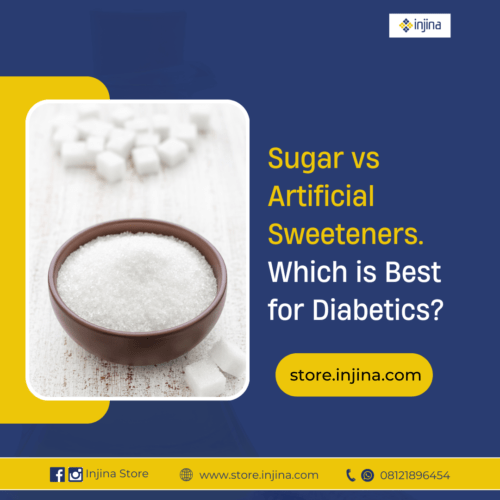Since it is no news that diabetes is a common occurrence, we’ve been thinking a lot about which is best for diabetics between sugar and artificial sweeteners.
We both know sugar isn’t exactly the best friend for blood sugar levels, but artificial sweeteners seem a bit mysterious. So, we dug into the research to see which is preferable for people with diabetes.
Here’s the thing: there’s no simple, one-size-fits-all answer. Both sugar and artificial sweeteners have pros and cons, and the best choice depends on your individual situation and diabetes management goals.
For people with diabetes, artificial sweeteners are generally a better choice than sugar. These are the reasons:
Sugar:
1. Natural Source: Sugar comes from natural sources like sugarcane or sugar beets. It’s a simple carbohydrate broken down into glucose in the body, providing energy.
2. Calories: Table sugar contains 4 calories per gram.
What is the effect of taking sugar for Diabetic people?
Sugar raises blood sugar levels quickly. This can be problematic for people with diabetes who need to manage their blood sugar carefully.
Artificial Sweeteners:
1. Chemical Structure: Artificial sweeteners are man-made, low-calorie, or calorie-free substitutes for sugar. They are created in a lab to mimic the sweetness of sugar but without the same chemical structure.
2. Minimal Calories: Most artificial sweeteners have minimal to no calories, making them appealing for weight management and diabetes control.
Sugar vs Artificial Sweeteners. Which is Best for Diabetics?
Artificial sweeteners are the most preferred for diabetic people. This is because artificial sweeteners have little to no impact on blood sugar levels. This happens because the body doesn’t fully absorb them or use them for energy.
Keep in mind that you may not always find artificial sweeteners around because they are processed in the lab. Sometimes, they are very costly to buy.
But there is a BETTER SOLUTION.
Do you know you can have a stable blood sugar no matter what you eat? YES! Our Green Veggies Detox Tea can REDUCE HIGH BLOOD SUGAR to the extent that it becomes normal, forever.
There is no need to doubt. Click here to read how it works.
It is also important to understand how Sugar and Artificial Sweeteners are processed. This gives us more insight into how healthy both of them are.
There are two main types of commercially produced sugar: sucrose (table sugar) and high-fructose corn syrup (HFCS).
Sucrose (Table Sugar):
- Extraction: Sugarcane or sugar beets are crushed to extract their juice.
- Clarification: The juice is treated with lime or phosphoric acid to remove impurities like proteins and minerals.
- Evaporation: The juice is heated to remove water, concentrating the sugar content.
- Crystallization: The concentrated syrup is cooled and seeded with sugar crystals, triggering the formation of larger crystals.
- Centrifugation: The mixture is spun in high-speed machines, separating the sugar crystals from the molasses (a thick syrup).
- Drying and Refining: The crystals are dried and further refined to remove any remaining impurities and achieve a uniform white color.
High-Fructose Corn Syrup (HFCS):
- Starch Conversion: Cornstarch is broken down into glucose using enzymes.
- Isomerization: Some of the glucose is converted to fructose (a sweeter sugar) using another enzyme. The final product contains varying ratios of glucose and fructose depending on the desired sweetness level.
- Purification and Concentration: The syrup is purified and concentrated to remove impurities and achieve the desired consistency.
Artificial Sweeteners: A Chemical Creation
Artificial sweeteners are not extracted from natural sources; they are manufactured in factories. Here’s a simplified overview of the process for two common types:
Aspartame:
- Starting Materials: Aspartic acid and phenylalanine (amino acids) are combined.
- Reaction: These amino acids react under specific conditions to form aspartame.
- Purification: The aspartame is separated from other reaction products and purified.
- Crystallization and Drying: The purified aspartame is crystallized and dried to create a stable powder.
Sucralose:
- Starting Material: Sucrose (table sugar) is the starting point.
- Selective Chlorination: Specific hydroxyl groups in the sucrose molecule are replaced with chlorine atoms using a chlorination process. This alters the sweetness and prevents the body from breaking it down.
- Purification and Crystallization: Similar to aspartame, the modified sucrose is purified and crystallized to create a usable product.
Important Note: These are simplified explanations, and the actual manufacturing processes can involve more complex steps and additional ingredients depending on the specific sweetener.


Leave a Reply